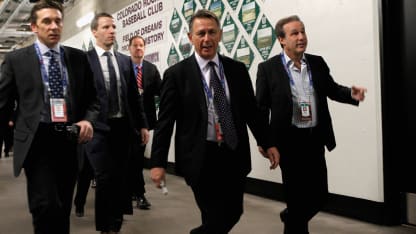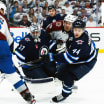MONTREAL -- The 44th player who changes NHL jerseys Monday -- should that many be traded -- will become a footnote in history, the 1,000th to relocate when push came to deadline shove.
A whopping 956 players have changed teams on NHL Trade Deadline day since the League began charting these transactions in 1980. A total of 520 trades have been made, with 330 draft picks among the bodies shuffled between teams.
Trade Deadline routinely changes NHL landscape
Monday could see 1,000th player moved on final day of dealing

Of course, this doesn't include the flurry of trades made in the days and weeks leading up to the final day, which in itself has become a multimedia feeding frenzy as clubs buy to bolster their playoff chances or, if they're headed to an early offseason, sell in a bid to improve their future and shave a few dollars from the salary cap bottom line.
Forty-four players changing teams on Monday before the 3 p.m. ET deadline would make this the busiest deadline since 55 were traded on March 3, 2010, the most hectic day ever. It would be one more player than last season and the fourth busiest ever.
The quietest day -- thankfully, sports television wasn't covering it around the clock -- was in 1983, the only trade sending Ken Solheim from the Minnesota North Stars to the Detroit Red Wings for future considerations.
There have been players who, through experience, were wise enough to keep their suitcases packed with the deadline at hand:
Alan May was traded in 1988, 1989, 1994 and 1995, making him the leader in address changes.
For those keeping score at home: May went from the Boston Bruins to the Edmonton Oilers, then from Edmonton to the Los Angeles Kings, each of those trades at the deadline. He was shipped from Los Angeles to the Washington Capitals in June 1989, then again on deadline went from Washington to the Dallas Stars, and from Dallas to the Calgary Flames.
Dan McGillis, Mark Janssens, Mike Gartner and Steve Konroyd were traded three times each at the deadline.
Nine first-round draft picks have been traded, three of them changing hands in 2008.
Peter Mueller has proven to be the most offensively prolific of the pool of 956 deadline-traded players to date, scoring nine goals and adding 11 assists in 15 games for the Colorado Avalanche when traded there in 2010 from the now-Arizona Coyotes.
At the best of times, a hockey trade is an inexact science; it's an equation that is part a team's need, part its vision for its future, the research of scouts (and now analytics experts), and part the hunch of a general manager who has found a fellow GM with whom to dance, each side hoping the transaction is sprinkled with stardust.

Sometimes, however, it's showered with dirt.
Never is this equation more apparent than at the trade deadline, when every team is looking to either add by addition or by subtraction, and when a huge number of the players are rentals, short-term additions in the push to the Stanley Cup Playoffs who upon unrestricted free agency can be headed elsewhere.
The day of UFA frenzy is anticipated by fans for the often-prime talent that will relocate to or from their teams, and the NHL Draft is great fun for the promise down the road of the young men selected over two days.
But each of those events take place during the League's offseason. Trade deadline takes place in the heart of the NHL schedule, the playoffs looming, and results, for better or worse, are seen instantly.
Grading the trades, of course, is highly subjective. But over the years, a handful have stood out for the impact they've had, especially in the short term.
A sentimental favorite, a transaction that in fact took place eight days before the March 14, 2000 deadline, has to be the acquisition by the Avalanche of future Hall of Fame defenseman Ray Bourque from the Boston Bruins.
Bourque finished out the year in Denver and stuck around as a 40-year-old to finally win the Stanley Cup that had eluded him for two decades in Boston.
There was the New York Islanders' 1980 acquisition, the day before deadline, of gritty Butch Goring from the Kings for Billy Harris and Dave Lewis. On Long Island, under his helmet that was so ugly as it was beautiful, Goring would be a key cog in the Islanders machine that won four consecutive Stanley Cups from 1980-83.
Goring was stunned by his March 1980 trade to the Islanders, figuring that in the second year of a six-year contract, he'd be with the Kings for life.
But then Islanders general manager Bill Torrey dealt for him.
Dispatching Harris meant parting with the first player drafted in Islanders history. And coming east from the Kings was a very unhappy man.
"I was very angry," Goring said a few months ago during a talk about his remarkable career. "But when I got to Long Island and had time to process what was going on, I saw this was a chance to be something really good.
"These guys were good. I wasn't going in there to be the difference-maker. This was a team that, without me, has a chance to win the Cup. With me, in my opinion, it has a better chance."
The Islanders went 8-0-4 upon Goring's arrival, then rolled to their first Stanley Cup. Three more followed, putting them on the cusp of a share of history, only the 1956-60 Canadiens having won five consecutive titles.

Into the 1984 Stanley Cup Final they went, having rallied from a 2-0 deficit against the Montreal Canadiens to win a six-game Eastern Conference Final. Goring had never experienced a playoff-series defeat with New York, the Islanders on which he played having won an unprecedented 19 straight series.
But they ran into a buzzsaw wearing Edmonton Oilers jerseys and lost a five-game Stanley Cup Final. The Canadiens' run of five straight championships remains intact to this day, and seems unlikely to ever be matched.
Other trades at the deadline have had huge impacts, if not in the very short term, then down the road:
On 2013 trade deadline day, the Tampa Bay Lightning landed goaltender Ben Bishop from the Ottawa Senators for forward Cory Conacher and a draft pick; Bishop has been a tower, literally and figuratively, in the Lightning net since he arrived in Tampa Bay.
Marian Gaborik went to Los Angeles from the Columbus Blue Jackets on March 5, 2014, traded for forward Matt Frattin and two draft picks. Gaborik quickly became a first-line wing, helped pace the Kings in 2014 to their second Stanley Cup title in three seasons, and signed a seven-year contract last summer.
Add these headline-making trades, while you tack on your own favorites:
Markus Naslund to the Vancouver Canucks from the Pittsburgh Penguins in 1996; Filip Forsberg to the Nashville Predators from Washington in 2013; The Penguins landing Ron Francis, Ulf Samuelsson and Grant Jennings from the Hartford Whalers in 1991.
On Monday, countless general managers -- that is, fans of every NHL team -- will be making huge trades that will push their favorites over the top. Some of them will even respect the harsh realities of the salary cap, but why let the nuisance of reality get in the way of a blockbuster?
On Monday night, as the dust settles, the contenders and the pretenders will settle in for the final six weeks of the regular season with an eye on the playoffs or the rebuilding projects ahead.
That will be more than enough time to grade the work they have done in the madness that is NHL Trade Deadline.
And for the media and fans to second-guess the decision-making that once again changed the hockey landscape.

















